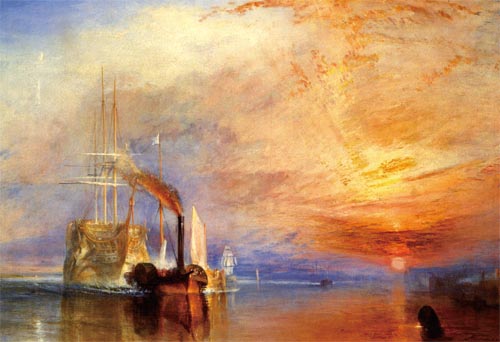Engines fuel artists in the era of industry

“The Fighting Temeraire” (1838) by J. M. W. Turner. Oil on canvas. The National Gallery, London
전함 테메레르(1838),J M W 터너(1775~1851)작, 캔버스에 유채, 91×122㎝ 내셔널 갤러리,런던
A painting by J. M. W. Turner (1775-1851) shows a grand ship with its sails down being towed by a smaller black steamer, with the sky and the water glowing red and gold in the sunset. The title of the work by the English master of Romantic landscape painting is “The Fighting Temeraire.” But which ship is the Temeraire?
*steamer : 증기선
*Romantic landscape painting : 낭만주의 풍경화
석양이 하늘과 물을 붉은색과 금빛으로 물들인 가운데, 돛을 내린 거대한 범선이 그보다 작은 체구의 검은 증기선에 이끌려가고 있다. 영국 낭만주의 풍경화의 거장 J M W 터너(1775~1851)가 그린 이 그림(사진 1)의 제목은 ‘전함 테메레르(1838)’인데, 두 배 중 어느 쪽이 그 전함일까?
The painting’s original title is “The Fighting Temeraire Tugged to Her Last Berth to be Broken Up.” Therefore, the Temeraire must be the sailing ship, which looks majestic but pale.
*tug : 세게 잡아당기다 예인하다
*berth : 정박지
*sailing ship : 범선
이 그림의 원제는 ‘해체를 위해 최후의 정박지로 이끌려가는 전함 테메레르’다. 저 장대하지만 창백한 범선이 테메레르인 것이다.
According to the National Galley to which the painting belongs, the warship Temeraire played a distinguished role in Britain’s victory at the Battle of Trafalgar in 1805, which finally brought about the fall of France’s Napoleon Bonaparte.
*play a distinguished role : 활약을 하자, 무훈을 세우다
*warship : 전함
테메레르는 1805년 트라팔가르 해전에서 영국의 승리와 프랑스 나폴레옹의 몰락을 가져온 이름 높은 전함이었다.
But even the warship, which had been loved by the British people for its distinguished military service, was finally decommissioned in 1838. Turner happened to see the old warship being towed to be broken up near the River Thames estuary and made sketches of it, which he then worked into the painting.
*decommission : (함선 등을) 퇴역시키다, 무기를 해체하다
*estuary : 어귀
그러나 영국 국민의 사랑을 받던 이 용맹한 배도 증기선 시대가 도래하면서 1838년 결국 해체의 운명을 맞게 됐다. 터너는 그날 마침 템스 강 어귀에 갔다가 이 노장의 장례 행렬과도 같은 모습을 보게 됐고, 그때 받은 강렬한 인상을 그림에 담았다.
The setting sun seems to tell of the warship’s past glory and its present downfall. The shining veil of golden clouds made by the sunset looks just like a last salute for a passing war veteran. And the flaming smoke that the steamer belches contrasts with the last light of the sunset, declaring the beginning of a new era.
*salute : 경례
*war veteran : 노병
*belch : 내뿜다
떨어지는 태양은 과거의 영광과 현재의 쇠락을 말해주는 듯하고, 그 석양이 만든 찬란한 금빛 구름 휘장은 죽음을 맞는 노병에게 보내는 최후의 경례처럼 보인다. 그리고 증기선이 뿜어내는 불 같은 연기는 그 석양의 마지막 빛과 대구를 이루며 새 시대의 시작을 알린다.
Although the painting represents a real scene, it looks symbolic, because it would be difficult to present a more dramatic representation of the decline of an old era and the rise of a new epoch than this painting does. Turner’s work vividly shows the changes wrought by the Industrial Revolution in Britain.
*symbolic : 상징적인
*Industrial Revolution : 산업혁명
실제 사건을 묘사한 그림인데도 마치 상징적으로 구성된 것처럼, 이 작품은 저물어가는 옛 문명과 떠오르는 새로운 기계문명의 충돌을 더할 나위 없이 드라마틱하게 보여주고 있다. 영국의 산업혁명 시대를 단적으로 보여주는 그림이 아닐까 싶다.
In broad sense, an “industrial revolution” is a transition from an agriculture-oriented economy to an industry-oriented economy in any period and any region. But in a narrow sense, it refers to the period of industrialization and the following socioeconomic and cultural changes in Britain that occurred between 1780 and 1840.
*in broad sense : 넓은 의미로
*industry-oriented economy : 공업 중심 경제
산업혁명이라는 말이 넓은 의미로 쓰일 때는 시대와 지역을 막론하고 농업중심 사회에서 공업중심 사회로 이행하는 것을 뜻하지만, 좁은 의미로 쓰일 때는 영국에서 1780년부터 1840년까지 일어난 대규모 산업화를 가리킨다.
The driving force behind the epochal change was the development of steam power, which was used to fuel the tugboat in Turner’s painting, and other technologies.
*steam power : 증기력
*tugboat : 예인선
그 변혁의 주요 동력은 터너의 그림 속 증기선에 사용된 것 같은 증기기관의 발명과 그밖의 기술 혁신이었다.
Of course, steam power was not the only thing that turned a society that depended mainly on agriculture and cottage industry into a society led by machine industry. Conditions for the change were being made in Britain in the 18th century. The feudal guild system was turning into the factory system, while petty farmers, who had become part of the landless working class due to enclosure processes, were rushing to work in the cities. In addition, raw materials including cotton were flowing into the country from the colonies, while its overseas markets were expanding.
*cottage Indus : 가내수공업
물론 증기기관의 발명만으로 갑자기 천지가 개벽하고, 농업과 가내수공업이 주를 이루던 사회가 기계공업 사회로 변모한 것은 아니다. 영국은 18세기부터 그 여건이 만들어지고 있었다. 봉건사회적 길드가 공장제 수공업으로 전환됐고, 농업의 대형화에 따라 몰락한 군소 농민들이 도시의 노동자가 됐다. 게다가 식민지 개척으로 면화를 포함한 풍부한 자원이 해외에서 들어오고 있었고 해외시장이 커지고 있었다.
JoongAng Daily 8면 기사 Tuesday, June 8, 2010
번역: 문소영 중앙데일리 문화생활스포츠 팀장(symoon@joongang.co.kr)










with the Korea JoongAng Daily
To write comments, please log in to one of the accounts.
Standards Board Policy (0/250자)